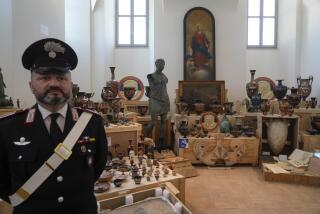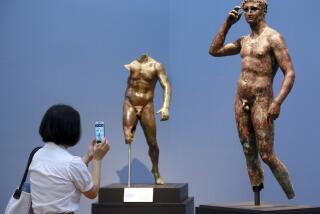Looted Obelisk Remains Pillar of Debate
- Share via
ROME — Piece by ancient piece, Italian engineers are delicately dismantling an intricately carved obelisk in southern Rome and wrapping it for delivery to Ethiopia.
In a move that sends a message to all nations attempting to recover looted artifacts, and to the governments and private collectors that hoard them, Italy is finally making good on a promise to return the Aksum Obelisk, capping decades of bitter dispute over the monument’s fate and home.
The 1,700-year-old obelisk is ranked by the United Nations Education, Scientific and Cultural Organization as an outstanding historic and artistic object and is cherished by Ethiopians as a pillar of their civilization. Aksum was the cradle of Ethiopian Christianity. Benito Mussolini’s forces seized the 75-foot-high monument in 1937, during Italy’s invasion of Ethiopia, and transported it to Rome as a trophy of fascist imperialism.
For the last 65 years or so, it has sat in relative obscurity in the polluted, traffic-choked Piazza Porta Capena in southern Rome, outside the former office for African colonies, with not even a plaque to note its presence. In this museum of a city, where every corner offers an architectural gem, including 13 ancient Egyptian obelisks, the entry from Aksum was hardly spectacular.
But to Ethiopians, the obelisk represented much more: Restitution was a matter of validating cultural heritage and obtaining international justice.
A spokeswoman for the Ethiopian Embassy in Rome said that her government was delighted that the monument was at last going home. Joy was tempered somewhat, however, by a history of broken promises, so Ethiopian officials are waiting until the spire makes it back before declaring the case closed.
The obelisk is one of three erected by the Aksumites in the northern plateau region of Aksum in the 4th century, before they adopted Christianity.
The 180-ton granite monument that was moved to Rome is considered the finest of the series because of its carvings. Geometrical shapes on all four flanks attest to the technical skills of the ancient African people, making it a source of pride.
Emperor Haile Selassie protested its removal at the time. Ambassadors have raised the issue repeatedly through the decades, in Rome and at the United Nations. Prominent Ethiopians joined by art lovers in many other countries mounted a petition drive.
Italy’s decision to give back the obelisk is likely to send shock waves through museums from New York to Cairo to Brentwood.
Throughout history, occupying armies, colonial occupiers or other unscrupulous agents have notoriously seized local artifacts and channeled them into a netherworld of art dealership that often asks few questions but supplies precious objects.
Greece, for example, has for years demanded restitution of the ancient Parthenon Marbles taken to Britain by Lord Elgin in the early 19th century. They are featured in the British Museum in London, where they seem likely to stay.
Looting aside, the art world is divided in debate: Leave archeological wonders where they were found, preserving history but limiting the ability of the world to appreciate them. Or, take the objects to museums where more people can view them, though not in their original location.
“I think it is appropriate that these artifacts go to where they belong, and not to museums,” said Giuseppe Infranca, an archeological expert who favors returning the Aksum to Ethiopia. Museums can make do with copies, he argues.
“To give the stele back is to give back the very image of the Aksum civilization in the place where it was born,” he said.
But resistance has been strong here as well.
Vittorio Sgarbi, an outspoken lawmaker with the ruling Forza Italia (Go, Italy) party and former Culture Ministry official, once said that because the Aksum Obelisk had been in Italy so long, it was as good as a “naturalized citizen.” He opposes repatriation.
“How many tourists go to Aksum?” he said. “They have no habits of viewing archeological sites there. Let’s say 20,000 people go to Aksum. And how many come to Rome? Ten million!”
Italian governments have previously agreed to return the obelisk but never acted on the promise. The administration of Prime Minister Silvio Berlusconi -- whose coalition includes the neofascist National Alliance -- finally relented after a lightning bolt last year embarrassingly knocked large chunks from the stone pillar.
Perhaps the Aksum case will not set precedent because its looting is relatively recent. Many of Rome’s other obelisks, for example, were taken from Egypt’s Valley of the Pharaohs many centuries ago.
In fact, the controversy over whether to give back the Aksum Obelisk has been supplanted by controversy over how to give it back. Carved from a single piece of granite, the obelisk was brought to Italy in pieces, and that’s the way it’s returning.
Several art and archeological experts, including Infranca, object to the government’s decision to chop it into three pieces (“like a salami,” says Infranca), arguing that irreparable damage is being done.
But Federico Croci, manager of the engineering firm in charge of the project, said dismantling has been handled with utmost care. There is no other way, he said, by air or by sea, to transport the column to Ethiopia.
“This is very complicated,” Croci said. “If we were just going to break it in pieces, [the project] would be easy. We’d just cut it.”
Instead, his crews are using a system of jacks to recreate stresses and tensions inside the obelisk and cause it to separate along existing seams of cement mortar, which are weaker than the rest of the construction, rather than breaking the actual stone.
The first 45-ton upper section, which took a full day this month to bring down, was placed in a metal cage-like contraption to protect it, Croci said. It sits in a warehouse near the airport, awaiting the rest of the monument to be dismantled.
Ethiopian Prime Minister Meles Zenawi, in a recent interview in Addis Ababa with The Times, said he believed that the Italians were finally serious about relinquishing the long-lost pillar.
“The Italians told us that they would do the right thing and we believe, this time, they will want to do the right thing,” said Meles, who spoke with Berlusconi during a hunger conference in Rome last year.
“The obelisk belongs in Ethiopia, not in Rome.”
*
Times staff writer Davan Maharaj, recently on assignment in Addis Ababa, contributed to this report.
More to Read
Sign up for Essential California
The most important California stories and recommendations in your inbox every morning.
You may occasionally receive promotional content from the Los Angeles Times.











